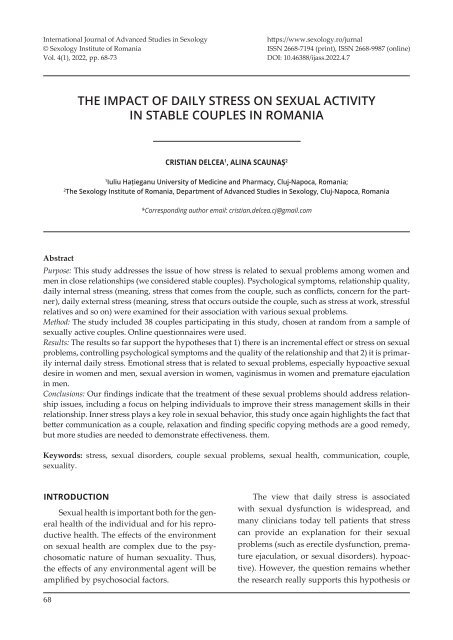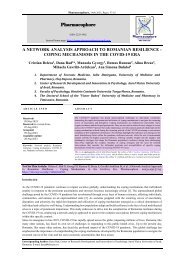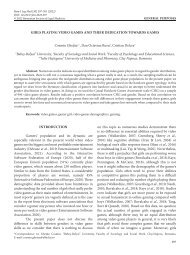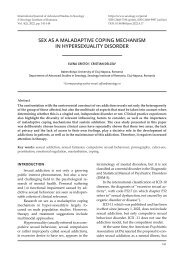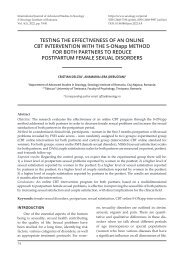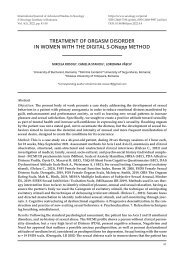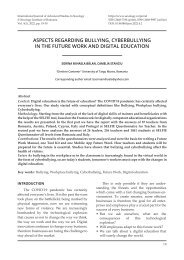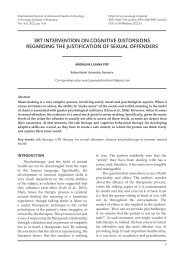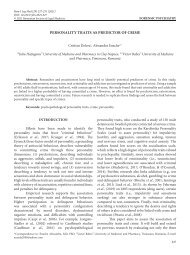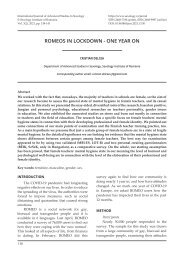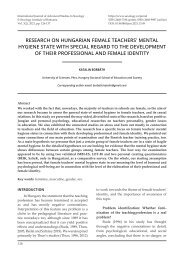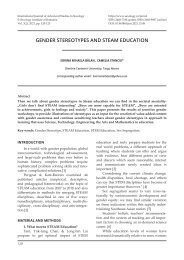THE IMPACT OF DAILY STRESS ON SEXUAL ACTIVITY IN STABLE COUPLES IN ROMANIA
Purpose: This study addresses the issue of how stress is related to sexual problems among women and men in close relationships (we considered stable couples). Psychological symptoms, relationship quality, daily internal stress (meaning, stress that comes from the couple, such as conflicts, concern for the partner), daily external stress (meaning, stress that occurs outside the couple, such as stress at work, stressful relatives and so on) were examined for their association with various sexual problems. Method: The study included 38 couples participating in this study, chosen at random from a sample of sexually active couples. Online questionnaires were used. Results: The results so far support the hypotheses that 1) there is an incremental effect or stress on sexual problems, controlling psychological symptoms and the quality of the relationship and that 2) it is primarily internal daily stress. Emotional stress that is related to sexual problems, especially hypoactive sexual desire in women and men, sexual aversion in women, vaginismus in women and premature ejaculation in men. Conclusions: Our findings indicate that the treatment of these sexual problems should address relationship issues, including a focus on helping individuals to improve their stress management skills in their relationship. Inner stress plays a key role in sexual behavior, this study once again highlights the fact that better communication as a couple, relaxation and finding specific copying methods are a good remedy, but more studies are needed to demonstrate effectiveness. them.
Purpose: This study addresses the issue of how stress is related to sexual problems among women and
men in close relationships (we considered stable couples). Psychological symptoms, relationship quality,
daily internal stress (meaning, stress that comes from the couple, such as conflicts, concern for the partner),
daily external stress (meaning, stress that occurs outside the couple, such as stress at work, stressful
relatives and so on) were examined for their association with various sexual problems.
Method: The study included 38 couples participating in this study, chosen at random from a sample of sexually active couples. Online questionnaires were used.
Results: The results so far support the hypotheses that 1) there is an incremental effect or stress on sexual
problems, controlling psychological symptoms and the quality of the relationship and that 2) it is primarily
internal daily stress. Emotional stress that is related to sexual problems, especially hypoactive sexual
desire in women and men, sexual aversion in women, vaginismus in women and premature ejaculation
in men.
Conclusions: Our findings indicate that the treatment of these sexual problems should address relationship
issues, including a focus on helping individuals to improve their stress management skills in their
relationship. Inner stress plays a key role in sexual behavior, this study once again highlights the fact that better communication as a couple, relaxation and finding specific copying methods are a good remedy, but more studies are needed to demonstrate effectiveness. them.
You also want an ePaper? Increase the reach of your titles
YUMPU automatically turns print PDFs into web optimized ePapers that Google loves.
International Journal of Advanced Studies in Sexology<br />
© Sexology Institute of Romania<br />
Vol. 4(1), 2022, pp. 68-73<br />
https://www.sexology.ro/jurnal<br />
ISSN 2668-7194 (print), ISSN 2668-9987 (online)<br />
DOI: 10.46388/ijass.2022.4.7<br />
<strong>THE</strong> <strong>IMPACT</strong> <strong>OF</strong> <strong>DAILY</strong> <strong>STRESS</strong> <strong>ON</strong> <strong>SEXUAL</strong> <strong>ACTIVITY</strong><br />
<strong>IN</strong> <strong>STABLE</strong> <strong>COUPLES</strong> <strong>IN</strong> <strong>ROMANIA</strong><br />
CRISTIAN DELCEA 1 , AL<strong>IN</strong>A SCAUNAȘ 2<br />
1<br />
Iuliu Hațieganu University of Medicine and Pharmacy, Cluj-Napoca, Romania;<br />
2<br />
The Sexology Institute of Romania, Department of Advanced Studies in Sexology, Cluj-Napoca, Romania<br />
*Corresponding author email: cristian.delcea.cj@gmail.com<br />
Abstract<br />
Purpose: This study addresses the issue of how stress is related to sexual problems among women and<br />
men in close relationships (we considered stable couples). Psychological symptoms, relationship quality,<br />
daily internal stress (meaning, stress that comes from the couple, such as conflicts, concern for the partner),<br />
daily external stress (meaning, stress that occurs outside the couple, such as stress at work, stressful<br />
relatives and so on) were examined for their association with various sexual problems.<br />
Method: The study included 38 couples participating in this study, chosen at random from a sample of<br />
sexually active couples. Online questionnaires were used.<br />
Results: The results so far support the hypotheses that 1) there is an incremental effect or stress on sexual<br />
problems, controlling psychological symptoms and the quality of the relationship and that 2) it is primarily<br />
internal daily stress. Emotional stress that is related to sexual problems, especially hypoactive sexual<br />
desire in women and men, sexual aversion in women, vaginismus in women and premature ejaculation<br />
in men.<br />
Conclusions: Our findings indicate that the treatment of these sexual problems should address relationship<br />
issues, including a focus on helping individuals to improve their stress management skills in their<br />
relationship. Inner stress plays a key role in sexual behavior, this study once again highlights the fact that<br />
better communication as a couple, relaxation and finding specific copying methods are a good remedy,<br />
but more studies are needed to demonstrate effectiveness. them.<br />
Keywords: stress, sexual disorders, couple sexual problems, sexual health, communication, couple,<br />
sexuality.<br />
<strong>IN</strong>TRODUCTI<strong>ON</strong><br />
Sexual health is important both for the general<br />
health of the individual and for his reproductive<br />
health. The effects of the environment<br />
on sexual health are complex due to the psychosomatic<br />
nature of human sexuality. Thus,<br />
the effects of any environmental agent will be<br />
amplified by psychosocial factors.<br />
The view that daily stress is associated<br />
with sexual dysfunction is widespread, and<br />
many clinicians today tell patients that stress<br />
can provide an explanation for their sexual<br />
problems (such as erectile dysfunction, premature<br />
ejaculation, or sexual disorders). hypoactive).<br />
However, the question remains whether<br />
the research really supports this hypothesis or<br />
68
The impact of daily stress on sexual activity in stable couples in Romania<br />
whether the assumption that stress covariance<br />
with sexual dysfunction is just speculation.<br />
This study aims to investigate the association<br />
between emotional stress - internal versus<br />
external, minor versus major - and the various<br />
sexual problems in male and female partners<br />
living in close relationships (couple). The description<br />
of internal and external stress was<br />
taken over and defined according to the theoretical<br />
model proposed by Neff and Karney<br />
(2004). Internal stress is defined as the stress<br />
that originates within couple (conflicts and tensions<br />
that arise between partners in the form of<br />
different goals, divergent attitudes, needs and<br />
desires, habits of one partner that disrupt the<br />
other, a lack of compatibility between partners,<br />
or worries about the partner due to well-being<br />
and cases where one partner is affected by pain<br />
or private difficulties to a much greater extent<br />
than the other). External stress, on the other<br />
hand, is defined as stress that comes from outside<br />
the couple, mainly from the interaction between<br />
each partner and his social environment<br />
(for example, stressful meetings outside the<br />
couple that upset one or both partners). This<br />
type of stress includes stress at work, financial<br />
stress, social stress in the neighborhood or with<br />
friends, and stress related to extended family,<br />
such as stress with siblings, in-laws, and other<br />
relatives (Delcea C., Enache A., 2021). Child-related<br />
stress is also defined as external stress<br />
because it is not the stress inherent in the couple<br />
itself. Another distinction was considered<br />
in this study between major stress, critical life<br />
events such as severe illness, disability, unemployment,<br />
death of a significant person, major<br />
accident (according to Dohrenwend & Dohrenwend<br />
1974) and minor or daily stress (such as<br />
irritating, frustrating, and annoying demands<br />
in day-to-day environmental transactions,<br />
such as missing a bus, missing a meeting, or<br />
being late, according to Lazarus & Folkman,<br />
1984).<br />
The hypothesis I started with is that higher<br />
levels of stress are related to acute sexual<br />
problems. It is assumed, however, that the association<br />
with sexual problems is higher for<br />
internal stress in the couple than for external<br />
stress, because tensions between partners can<br />
have a more direct negative impact on their<br />
sexuality than external events that may even<br />
have the potential to stimulate activities. as a<br />
means of reducing stress and in response to<br />
factors in everyday life (according to McCarthy,<br />
2003). Another hypothesis considers that<br />
sexual problems are more closely related to minor<br />
stress than to major stress, because minor<br />
stress is very common and easily reverberates<br />
in married life, and for example Morokoff and<br />
Gillilland (1993) who found stronger associations<br />
between troubles. and sexual dysfunctions<br />
than between sexual problems and critical<br />
life events. A third hypothesis is that the<br />
results are similar for women and men, except<br />
that the frequencies of self-perceived sexual<br />
dysfunction are expected to be higher for<br />
women than for men.<br />
So far, only a few studies have been conducted<br />
to study the association between stress<br />
and sexual functioning. Some of the studies so<br />
far have focused primarily on the stress that<br />
comes from the couple (i.e., stress due to relationship<br />
conflicts, or marital discord and so<br />
on), showing that marital conflicts can be significantly<br />
linked to lower sexual satisfaction<br />
and dysfunction. For example, 70% of couples<br />
seeking marriage therapy in Schroder et al.,<br />
1994, reported sexual dysfunction, hypoactive<br />
sexual desire. sexuality and sexual functioning<br />
(such as intimacy - e.g., Harper et al., 2000, or<br />
endocrine processes - e.g., chronic stress is associated<br />
with lower testosterone levels, both of<br />
which are relevant to human sexuality according<br />
to Bancroft, 1993). ) or psychological and<br />
physical health, studies of direct associations<br />
between stress and sexual problems, such as<br />
sexual desire disorders (sexual desire hypoactive<br />
sexual disorder), sexual arousal disorders<br />
(male erectile dysfunction, female sexual<br />
arousal disorder) or orgasmic disorders are<br />
rare. However, many therapists believe that<br />
stress can be linked to erectile dysfunction in<br />
men and that stress and premature ejaculation<br />
are often reported to be associated with each<br />
other. Empirical evidence for these hypotheses<br />
is lacking so far as well as, in general, knowledge<br />
of the association between stress and sexual<br />
dysfunction in close relationships.<br />
69
DELCEA and SCAUNAȘ<br />
Theoretical hypotheses are more widespread<br />
than empirical data about these models.<br />
This is surprising because sexuality is a very<br />
sensitive area to stress in appropriate relationships<br />
(dyads), which deserves more attention.<br />
METHOD<br />
Objectives of the study<br />
This study addresses the issue of how<br />
stress is directly related to sexual disorders<br />
among women and men who are in a close relationship<br />
(married or in a stable relationship).<br />
Participants<br />
Statistical data: Thirty-eight couples took<br />
part, 74% of whom were married. The structure<br />
of the group is heterogeneous, 40% women between<br />
30-40 years old, 30% females between<br />
20-30 years old, and the rest over 40 years old;<br />
48% of men are between 30-40 years old, 15%<br />
between 20 and 30 years old and the rest over<br />
40 years old. No significant differences were<br />
found between married and unmarried couples.<br />
Seventy percent of couples have children<br />
Participating women reported an average<br />
relationship duration of M = 12.3 years (SD =<br />
7.6, range: 1-36 years), while men reported an<br />
average relationship duration of M = 12.4 years<br />
(SD = 7.5, range).: 1-37 years)<br />
16% of the participating women graduated<br />
from high school, 53% graduated from high<br />
school and 31% had a college or university degree;<br />
10.5% of men had a high school diploma,<br />
47% had a high school diploma and 42.5% had<br />
a college or university degree.<br />
Inclusion / exclusion criteria<br />
Participants in this study met the following<br />
criteria:<br />
1) to be over 18 years of age; and 2) not suffer<br />
from personality disorders or other neurocognitive<br />
problems or disorders.<br />
Description of the procedure<br />
The couples were recruited through acquaintances<br />
and social networks between September<br />
1st and October 31st.<br />
Procedure details (ethical)<br />
Couples were not offered any compensation<br />
for their participation in this study. Eligible<br />
participants gave their consent by means of an<br />
electronically signed consent form in which the<br />
legal regulations on the protection of individuals<br />
with regard to the processing of personal<br />
data provided for in Regulation 2016/679 (EU)<br />
and Directive 95/46 / EC have been complied<br />
with. and Law no. 506/2004 on the processing<br />
of personal data and the protection of privacy.<br />
Instruments<br />
The SCL-90-R questionnaire (Derogatis,<br />
1992) used in our study is a self-report questionnaire<br />
that assesses a wide range of psychological<br />
problems and psychopathological<br />
symptoms (such as somatization, obsessive<br />
compulsive symptoms, depression, anxiety,<br />
phobic anxiety, paranoid ideation and interpersonal<br />
sensitivity). The digital form instrumented<br />
in our research evaluates these symptoms<br />
(evaluated by 90 items) are evaluated on a<br />
5-point evaluation scale. The SCL-90-R is widely<br />
used and demonstrates good reliability, validity,<br />
and overall usefulness (Derogatis, 1992).<br />
Hassles short questionnaire - a short version<br />
of the original questionnaire was used<br />
(Kanner et al., 1981) which used only 37 times<br />
(out of 117 items in total, in original), the respondents<br />
having a scalp from 1 to 5, where 5<br />
indicates a high level of stress and 1 indicates<br />
a complete lack of measured stress. The data<br />
obtained from the applied questionnaire indicated<br />
a normal distribution of data, the P value<br />
values for each category of score obtained and<br />
reported by sex indicate values higher than<br />
0.05.<br />
Hassles Men, the lowest recorded score<br />
was 85 and the highest score was 152, Hassles<br />
Female the lowest recorded value is 89 and the<br />
highest recorded value is 156. Uplifts Men with<br />
the lowest value of 76 and the higher value of<br />
135 and Uplifts Women with 89 and 127 for the<br />
highest score recorded.<br />
DSM-V Diagnostic Questionnaire - A<br />
questionnaire was used to assess the frequency<br />
of several sexual problems that were assessed<br />
on a 5-point scale, indicating the frequency<br />
70
The impact of daily stress on sexual activity in stable couples in Romania<br />
of these problems (never, rarely, from time to<br />
time, often, very often). The different sexual<br />
problems were explained to the subjects by<br />
listing their symptoms. The following sexual<br />
problems related to women were assessed:<br />
sexual desire problems (hypoactive sexual<br />
desire), sexual aversion problems, sexual<br />
arousal problems (lubrication), orgasm<br />
problems and vaginismus. In men, sexual<br />
desire problems (hypoactive sexual desire),<br />
sexual aversion problems, erectile problems,<br />
orgasmic problems, dyspareunia and<br />
premature ejaculation were evaluated. In this<br />
study, a combined measure was used that<br />
includes the frequency of sexual problems and<br />
self-perceived pain. The value of the Cronbah<br />
coefficient for women is 0.80, while for men<br />
the initial value was 0.30 and we went on to<br />
improve the alpha coefficient by reducing some<br />
questions (9,10,11,12,13) and thus we obtained<br />
an alpha coefficient of 0.78.<br />
Procedure<br />
The different sexual problems were<br />
explained to the subjects by listing their<br />
symptoms. In this study, a combined measure<br />
was used that includes the frequency of sexual<br />
problems and self-perceived pain. Participants<br />
completed the electronic questionnaire. All<br />
participants answered the items formulated<br />
in the 3 questionnaires and then sent to the<br />
cloud system, where the answers of the test<br />
participants were stored.<br />
General linear regression models have been<br />
adapted to estimate the association between<br />
dependent variables (sexual problems) and<br />
independent variables (internal and external<br />
stress). The data analysis was performed by<br />
the “enter” method, which introduces all the<br />
variables in a block in one step, regardless<br />
of whether they are significantly related by<br />
criteria or not. The variables were grouped into<br />
2 blocks that were thematically linked. The first<br />
block contained the sum score of psychological<br />
symptoms (SCL-90-R), the second block<br />
included the two daily stresses (daily internal<br />
and external stress). We used regression<br />
analysis for two reasons: 1) hierarchical<br />
regression analysis, based on theoretical<br />
assumptions about how variables are related<br />
to criteria, and 2) this procedure allows us to<br />
enter one predictor or set of predictors at a<br />
time. to see how each contributes to explaining<br />
the change in criteria. All data collected were<br />
analyzed and processed in tabular format.<br />
RESULT<br />
The results presented in Tables 1 and 2 below<br />
show the frequencies of self-perceived sexual<br />
problems. Unexpectedly, the frequency of<br />
sexual problems reported by women was lower<br />
than that reported by men. Sexual desire problems<br />
were the most frequently identified problems<br />
for both women (49%) and men (28%). In<br />
women, orgasmic problems (41%) and sexual<br />
aversion (31%) were also assessed very often.<br />
In men, sexual arousal / erection (63%) and<br />
sexual aversion (43%) seem to be the most common<br />
in the area of sexual desire problems. The<br />
correlations between specific sexual problems,<br />
psychological symptoms, stress, are presented<br />
below. The correlations between specific sexual<br />
problems range from 0.887 for women to<br />
0.350 for men. The correlation between sexual<br />
problems and internal / external stress varies<br />
Mans Problem psychologic uplift stress intern/extern<br />
Problem sexual 0.35 -0.301 0.303<br />
stress intern/extern 0.189 -0.984<br />
uplift -0.229<br />
Woman’s Problem psychologic uplift stress intern/extern<br />
Problem sexual 0.887 -0.112 0.217<br />
stress intern/extern 0.178 -0.738<br />
uplift -0.119<br />
71
DELCEA and SCAUNAȘ<br />
from 0.217 in women to 0.303 in men. The correlation<br />
between internal / external stress and<br />
psychological problems in women is 0.178 and<br />
0.189 in men.<br />
Contrary to many people’s beliefs, the correlation<br />
between women’s sexual problems is<br />
higher than that of men. Psychological symptoms<br />
are positively associated with sexual<br />
problems in women and men.<br />
DISCUSSI<strong>ON</strong>S<br />
The present study does not claim to be<br />
one conducted in a university setting, but may<br />
suggest some interesting findings about the<br />
frequency of self-perceived sexual problems in<br />
married women and men and the relationship<br />
between different forms of stress and sexual<br />
dysfunction.<br />
It was found that among women, the<br />
most frequently reported sexual problem was<br />
hypoactive sexual desire (34%), followed by<br />
orgasmic problems (13%). Data on men revealed<br />
a high frequency of premature ejaculation in<br />
addition to sexual desire problems (13%). It is<br />
interesting to note that these sexual problems,<br />
however, cause only a moderate level of<br />
anxiety and pain among affected individuals,<br />
probably because the problems are alleviated<br />
in daily life by reducing sexual activity due<br />
to crowded living conditions. However, 68%<br />
of women reported moderate to severe pain<br />
related to hypoactive sexual desire, as did 38%<br />
of men. Almost 40% of women suffer from<br />
sexual arousal problems due to stress.<br />
Many of the sex problems that have been<br />
reported frequently in our world may be related<br />
to stress, so investigating the relationship<br />
between stress and sexual problems has been<br />
of great interest. The results or the association<br />
between stress and sexual problems support<br />
the hypothesis that sexual problems are<br />
progressively affected by stress in some way,<br />
after controlling some psychological symptoms<br />
and the quality of the relationship. Our findings<br />
show that predictors (especially daily internal<br />
stress, couple stress), accounted for between<br />
9% and 26% of the variation of sexual problems<br />
and up to 47% of specific sexual dysfunctions,<br />
such as problems with sexual desire, sexual<br />
aversion, or premature ejaculation.<br />
Internal daily stress was found to play<br />
a crucial role in understanding sexual<br />
dysfunction, while critical life events seemed<br />
less important (effects found only in men),<br />
and external daily stress had no effect. It is<br />
noteworthy that the daily internal stress was<br />
even able to explain the progressive variation of<br />
sexual problems, in addition to psychological<br />
problems and the quality of the relationship. In<br />
women, all sexual problems (except orgasmic<br />
problems and dyspnea) were associated with<br />
daily internal stress, but not with psychological<br />
problems (measured by the SCL-90-R scale).<br />
Interestingly, in men, psychological<br />
problems were the best predictors of sexual<br />
problems. Moreover, they showed control<br />
over psychological problems, only erectile and<br />
orgasmic problems and premature ejaculation<br />
related to stress (daily internal stress and critical<br />
life events). The quality of the relationship<br />
was not related to sexual dysfunction in men.<br />
Again, this finding is of great importance for<br />
clinical theory and practice.<br />
However, this study has some limitations,<br />
which we assumed from the very beginning.<br />
The first limitation concerns the cross-cutting<br />
nature of the study design. It is not possible to<br />
differentiate the direction of the associations<br />
between stress and sexual problems addressed<br />
in this study. Although, sexual problems<br />
may increase internal stress (dyadic conflicts,<br />
partner tensions, partner worries), and it is<br />
also very plausible that internal stress will<br />
cause more sexual dysfunction. However, a<br />
longitudinal study (or even a study using a<br />
quasi-experimental design) that addresses<br />
subject-level analysis (ego, journal-based) is<br />
needed to answer this question of causality.<br />
Another limitation is that this study was<br />
based on sexual self-assessments and the<br />
diagnosis was not made by a clinician or a<br />
sexual expert. However, because the DSM-V<br />
criteria were used to assess sexual problems,<br />
it is very likely that self-perceived sexual<br />
disorders are also clinically relevant.<br />
Another limitation of this study could<br />
be that, due to our recruitment strategy, it is<br />
72
The impact of daily stress on sexual activity in stable couples in Romania<br />
likely that only couples who were directly<br />
and directly interested in the subject studied<br />
participated in this study, this fact could<br />
influence our conclusions, but an assessment is<br />
difficult. to do now.<br />
Despite the limitations of this study, in<br />
terms of causation, it should be noted that<br />
stress, especially daily internal stress, plays<br />
an important role in female and male sexual<br />
dysfunction, and this adds to the variation<br />
explained by the quality of the relationship or<br />
psychological symptoms.<br />
C<strong>ON</strong>CLUSI<strong>ON</strong>S<br />
The aim of this study was to investigate<br />
the link between sexual problems and<br />
everyday stress, as well as to consider what the<br />
implications of this might be for the prevention<br />
of stress in couple therapy. Knowing that<br />
mainly internal stress (and not external stress)<br />
can play an important role in sexual problems<br />
(at least in some types of sexual problems, as<br />
discussed above), a key element of intervention<br />
can focus on this type of stress. General<br />
stress management skills (such as relaxation<br />
techniques and so on) may be of limited<br />
relevance and utility, as it appears that stress<br />
is primarily directly related to sexual desire<br />
and arousal problems, problems with sexual<br />
aversion and premature ejaculation. Our results<br />
only suggest that these sexual dysfunctions<br />
would benefit from an intervention aimed<br />
at improving couples’ communication and<br />
conflict resolution, variables that differ from<br />
the quality of the relationship. In the treatment<br />
of sexual dysfunction, the prevention of stress<br />
in the couple seems to be of much greater<br />
importance than the prevention of stress in<br />
relation to external stress, such as stress at<br />
work. Thus, marital interventions, which focus<br />
on improving coping, reciprocity, fairness<br />
and mutual respect, as previously proposed<br />
by research teams and may be appropriate in<br />
the context of dealing with sexual problems.<br />
Further studies are needed to investigate the<br />
accuracy of such approaches to the prevention<br />
and treatment of sexual disorders.<br />
BIBLIOGRAPHY<br />
1. Aubin S, Heiman JR (2004) Sexual dysfunction<br />
from a relationship perspective, The Handbook<br />
of Sexuality in Close Relationships (pp47-518)<br />
2. Bancroft J (1993) Impact of environment,<br />
stress, occupational and other hazards on<br />
sexuality and sexual behavior, Environ Health<br />
Perspective 101-197<br />
3. Impact of Environment, Stress, Occupational<br />
and Other Hazards on Sexuality and Sexual<br />
Behavior- by John Bancroft Environmental<br />
Health Perspectives Supplements 101 (Suppl.<br />
2): 101-107 (1993)<br />
4. Bodenmann G, Shantinath SD (2004), The<br />
Couples Coping Enhancement Training<br />
(CCET): a new approach to prevention of<br />
marital distress based on stress and coping,<br />
477-484<br />
5. Derogatis LR (1992) SCL-90-R, Administration,<br />
Scoring and Procedures Manual II for the<br />
Revised Version and other instruments of the<br />
Psychopathology Rating Scale Series<br />
6. Dohrenwend BS, Dohrenwend BP (1974)<br />
Stressful Life Events: Their nature and effects,<br />
New York, Wiley<br />
7. Diagnostic and Statistical Manual of Mental<br />
Disorders (DSM – 5), Washington DC: American<br />
Psychiatric Association<br />
8. Delcea C., Enache A., (2021). Personality Traits<br />
as Predictor of Crime. Rom J Leg Med [29] 2,<br />
227-231 [2021] DOI: 10.4323/rjlm.2021.227..<br />
9. Lazarus RS, Folkman S (1984) Stress, Appraisal<br />
and Coping, New York, Springer<br />
10. Sandra R. Leiblum (2010.), Treating Sexual<br />
Desire Disorders - A Clinical Casebook, The<br />
Guilford Press<br />
11. McCarthy (2003) Marital sex as it ought to be, J<br />
Fam Psychoter 14-12<br />
12. Morokoff PJ, Gillilland R (1993) Stress, sexual<br />
functioning and marital satisfaction. J Sex Res.<br />
30: 43-53<br />
13. Neff LA, Karney BR (2004) How does context<br />
affect intimate relationships?, Per Soc Psychol.<br />
134-148<br />
14. Strauss B (1999) Cultural change with regard to<br />
sexuality and its implication for psychotherapy,<br />
Psychotherapy 270-278<br />
15. Yarber, W.L., Sayad, B.W. (2019), Human<br />
Sexuality Diversity in a Contemporary Society,<br />
McGraw-Hill Education<br />
73


